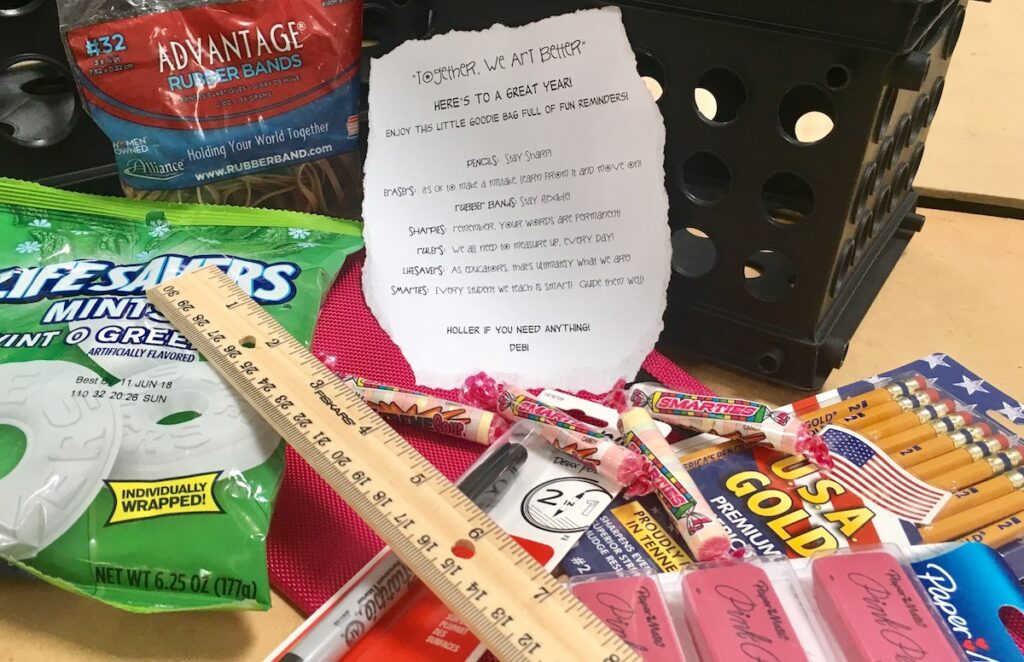Have you ever considered being the head of your visual arts department? When I was teaching at the elementary level, I was asked to chair our team of specialists. I’m not sure I ever had truly seen myself in that role, but I jumped in and have never looked back!
At first, I was hesitant. Was I ready for the extra responsibilities? Was I “leadership material”? It turns out, the answer to both questions was yes! Over the past 15 years, I have learned the ins and outs of being a successful department chair at both the elementary and secondary level. If you’re considering taking a leadership position in your department, I have five tips to share with you today! I also asked some of my colleagues in leadership positions to share their thoughts, which are included in the tips below.
5 Important Tips for Art Department Chairs
1. Leadership is all about teamwork.
Make sure your team knows you value their voices and opinions. When you communicate the ultimate goal is to work together, your team will be successful. Kirby Meng, a lead teacher in Henry County, Georgia, echoed this sentiment saying, “This job is about appreciating the talents of your department team, and being willing to delegate to others when it makes sense.”
During my very first meeting in a leadership position, I was excited but also nervous. So, during our first meeting, I brought a goodie bag of school supplies for each teacher to remind them we’re all in this beautiful thing called teaching together.
I included:
- Pencils (Stay sharp.)
- Erasers (It’s OK to make mistakes.)
- Rubber bands (Stay flexible.)
- Sharpies (Remember, as an educator, your marks can be permanent.)
- Rulers (We all need to measure up.)
- Lifesavers (As teachers, that’s what we are!)
- Smarties candies (Every student we teach is smart. It’s our job to help them reach their potential as we build their confidence.)
I’ve made changes and additions over the years, but the overall goal remains the same: to remind us we’re all striving for the same goal, which is being the best we can for our kids. We share strategies and have fun.
Like my friend and colleague, Dallas Gillespie, told me, “Leadership is about sharing successes and learning from one another.”

2. Be prepared to communicate effectively with others.
As the department chair, you may have to attend extra meetings and bring news, both good and bad, back to your team. How you communicate this news is critically important.
For example, at the high school level, I was both the visual arts department chair and a co-chair of the fine arts department with the chorus teacher. At my first “big” meeting, I was told our grading procedures were about to change, and my fine arts colleagues were not going to be happy with the new system. GULP.
I had to consider how I could bring this news back to my team without causing complete chaos. Instead of being upset, I brought my team a creative list of ways we could make the new system work. I also asked my team members for additional ideas. After meeting with my visual arts team, I set up a meeting with our administration and lobbied for a compromise. And you know what? It worked! The administrative team was impressed with our suggestions. Plus, my team was happy they were heard. They truly felt their voices mattered.
Drew Brown, an art educator in Fulton County, Georgia, summed it up nicely saying, “A good department chair is an advocate who can speak for the group, take concerns to the administration, and can present information in an organized and efficient manner. Essentially, they are a great communicator!”
3. AAA – Accept, Appreciate, and Acknowledge everyone!
When I moved to the high school, my co-chair gave me a fabulous book by Neila Connors called If You Don’t Feed the Teachers They Eat the Students! (You want it already, right?) It’s truly one of the best leadership books I’ve read. It’s a quick, easy read with tons of practical tips. In her book, she mentions what I like to call the “Triple A’s” which are Accept, Appreciate, and Acknowledge. In short, the theory suggests when you accept, appreciate, and acknowledge others, several wonderful things begin to happen.
- People come to the table with respect.
- People are willing to go the extra mile.
- Attitudes start to change for the better.
Let’s face it, we’re all different, and we all have different versions of what works best for our students. This fact has the potential to make for tricky group dynamics. But, when everyone knows they can openly express their ideas in a safe environment, it’s a win-win for the whole team.
In addition, as a department chair, you can search for professional opportunities that fit each team member’s needs. Art Ed Pro is a great resource because it’s so customizable, and new videos and resources are added each month. Conferences, courses, and local opportunities are also great things to consider.

Brooke Adamson, a fine arts department chair in my school district, had some ideas for how to put the “Triple A’s” into practice. “We celebrate our team members by talking about personal goals we have met and classroom activities that were successful. Of course, there is lots of applause! We also have each person share something they feel they do really well.”
Often, we forget to publicly recognize the contributions of others, so this idea of the “Triple A’s” is one that can go far in leadership and life!
4. Organization matters.
I can’t say enough about how important it is to stay organized. Personally, I keep a binder with agendas, notes, and ideas. I create a new binder for each year, so I can easily stay organized. Of course, you can also do this digitally, but the “old school” Debi, likes to print off important e-mails and keep doodled notes. Do what works for you!
5. A good sense of humor and a smile will take you far!
Finally, I have found a fun sense of humor and an authentic smile make for a good team leader. We can’t take ourselves too seriously. Over the years, I have seen leaders come and go. The ones who tend to stay are the listeners and the ones who bring light and joy to every meeting, even serious ones. It should always be about advocating for what is best for the team and for students, so even in the face of drama or tension, look for common ground and try to keep things light!
I hope this quick list inspires many of you to take a closer look at considering the important decision to become a team leader or department chair. I promise, you won’t regret it, and you will learn and grow both professionally and personally.
Does your school have a team lead or department chair?
Have you ever considered applying for this position? Why or why not?
Magazine articles and podcasts are opinions of professional education contributors and do not necessarily represent the position of the Art of Education University (AOEU) or its academic offerings. Contributors use terms in the way they are most often talked about in the scope of their educational experiences.





